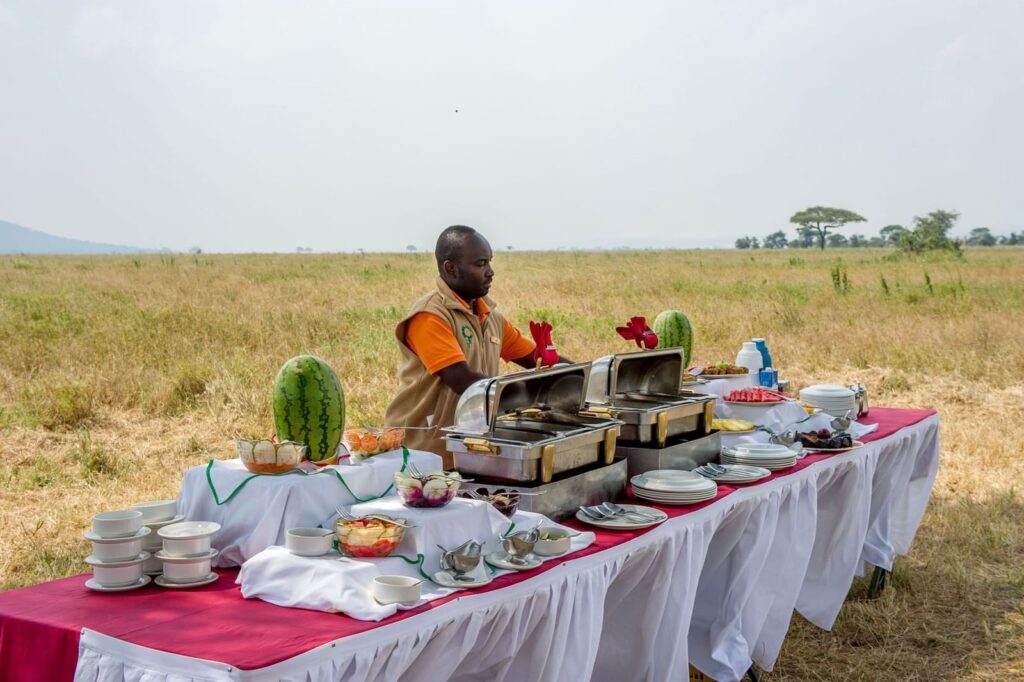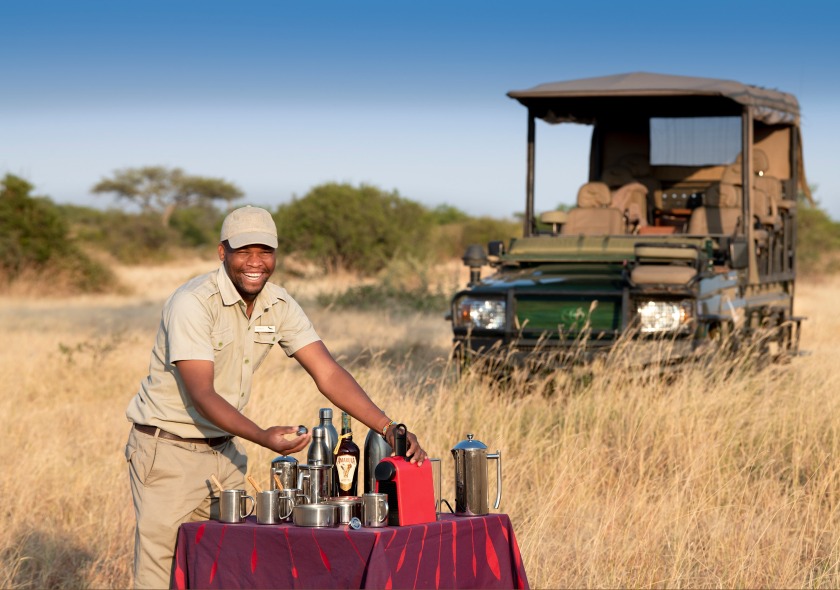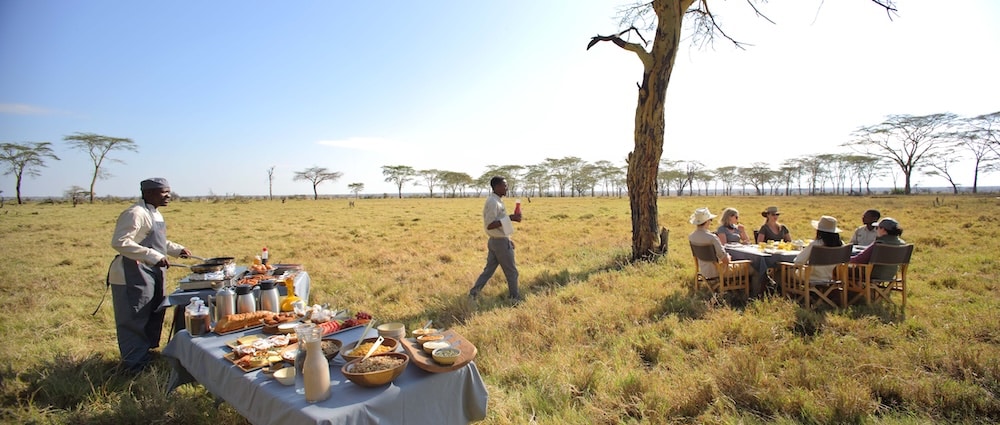Bush Dining in Serengeti National Park
Bush Dining in Serengeti National Park, Bush dining is highly favored in African safari locales such as Kenya, Tanzania, South Africa, Botswana, and Namibia, where opulent hotels and camps arrange al fresco dinners amidst the Savannah or deep within the forest. The bush eating experience can vary with the seasons, ranging from balmy days suitable for al fresco dining to cooler nights where fireplaces and blankets provide warmth and comfort. Envision tables illuminated by lanterns, the fragrant scent of grilled meats, and regional delicacies presented as elephants wander close or lions roar in the background.

Bush dining provides a distinctive connection to the land and its inhabitants, above mere sustenance. The cuisine frequently incorporates locally obtained products, traditional recipes, and narratives reflecting the region’s background. Bush eating is a profound celebration of nature and flavor, whether for a romantic dinner for two, a family gathering, or an organized group. Bush Dining fosters economic and sustainable development within the surrounding community, since numerous resorts permit local chefs to create bush dinners, procure products from adjacent farms, and adhere to environmentally sustainable techniques.
For any intrepid tourist pursuing extraordinary wildlife safari experiences in Tanzania, bush eating should be a priority on your itinerary. Bush eating provides a more immersive experience by integrating adventure, luxury, and genuine ethnic interactions in ways that conventional restaurant meals cannot. Bush dining elevates a mere meal into an indelible experience, whether for a proposal, an anniversary, a romantic getaway, or cultural explorations. Consequently, as a guest, ensure you propose it on your safari if it is not already incorporated in the program timetable.
What defines bush dining?
Bush dining denotes a distinctive outdoor culinary experience usually provided in secluded natural environments, such as the African wilderness, woods, or riverbanks, during a safari or nature-oriented retreat. It amalgamates artisanal or traditional cuisine with the picturesque allure and auditory ambiance of the forest, frequently beneath the stars and in proximity to a bonfire. Ideal for romantic evenings or exclusive group gatherings, it offers an unforgettable experience of sophistication and adventure. Bush eating started as a means for safari travelers to savor meals amidst nature, combining adventure with comfort. Dining in the bush at any hilltop offers panoramic views over the plains, creating a stunning sundowner experience.

The Bush dinner originated as a means to enjoy meals in the stunning bush, frequently on exhilarating safaris. The cuisine offered during a bush meal features local, fresh products prepared over open fires or grilled meats, merging traditional recipes with gourmet enhancements. After a day filled with activities such as game drives or walking safaris, it is delightful to relax with a torchlit barbecue dinner in the heart of the National Park, sharing stories around the bonfire and admiring the stars under the vigilant guardianship of the surrounding community.
Historically, bush meals originated as sustenance for hunters who developed a habit of not bringing home their catch after a long, arduous day of hunting. This gradually led this group of hunters to abandon their cultural practice of maintaining a balanced diet consisting of fresh meat, stew, and vegetables, as they exclusively consumed meat during the bush feasts. They also overlooked occasions of congregating around fires, exchanging narratives and a delectable feast, reinforcing their bond with nature and one other. This experience has transitioned from rustic to a more contemporary notion, while numerous old components persist unaltered.
While engaging in bush dining, it is prudent to exercise caution regarding certain staff members, such as remaining near your guide or ranger when traversing to and from the dining area, adhering to the directives given by staff concerning wildlife interactions, donning suitable footwear and attire, utilizing biodegradable products whenever feasible to preserve the environment, participating respectfully in cultural activities such as storytelling or drumming, applying insect repellent as recommended to avert bites, and notifying lodge staff in advance of any allergies or dietary restrictions to guarantee a safe and pleasurable experience.
Essential aspects of bush dining.
When engaging with nature, honoring local culture, and savoring exquisite cuisine in a remarkable environment, as part of various African safaris or eco-tourism experiences, the following are the essential attributes:
Location:
Bush dining typically occurs in natural settings, frequently at clearings, riverbanks, or picturesque outdoor locations. This is typically located at a considerable distance from hotels or lodges, ensuring that you can savor the natural animal ambiance during your meal. This location is a perfect venue for romantic dinners, honeymoon experiences, family gatherings, or special occasions. Bush dining occurs in national parks such as Serengeti, Ruaha, Tarangire, and Manyara. In the Serengeti, bush dining can occur in locations such as broad savannahs, behind acacia trees, or amid rocky kopjes, providing expansive vistas and a high density of wildlife.

A Bush dining experience generally entails arranging tables and chairs in a picturesque spot, complemented by a campfire for warmth, the rustic ambiance of the bush, or opulent arrangements using lanterns, a central bonfire, and a starlit sky.
The Bush dinner features a variety of foods crafted by local chefs from the adjacent community, encompassing both traditional local cuisine and international dishes, all freshly made on-site, frequently over open fires. For instance, grilled meats, chapati, and indigenous breads.
Experience:
Numerous bush dining experiences incorporate cultural components such as indigenous music, drumming, dancing (notably Maasai performances in the Serengeti), or storytelling to enhance the ambiance, alongside stargazing and occasional wildlife observations. The experience is crafted to be immersive, linking you with the unspoiled splendor of Tanzania.
Dining expenses in Serengeti National Park
The expenses associated with bush eating can fluctuate significantly based on factors such as location, season, lodge classification, group size, luxury level, and the specifics of the experience provided. Luxury lodges frequently incorporate bush dining into their offerings. Reservations for bush dining in the Serengeti are required in advance due to the seasonal nature of certain events. Serengeti offers group pricing for groups of four (4) or more individuals.
Expenses are categorized into three tiers: standard bush dining experience ($60-$100 per individual), premium bush dinner with sundowners ($120-$180 per individual), and luxury private bush dining experience ($250-$500 per individual).
